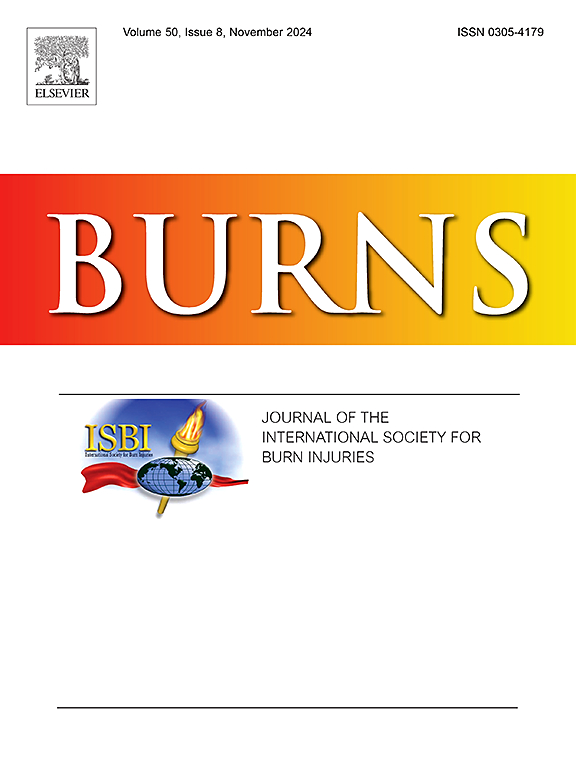Effect of early administration of inhaled heparin on outcomes of smoke inhalation injury: A randomized controlled trial
IF 3.2
3区 医学
Q2 CRITICAL CARE MEDICINE
引用次数: 0
Abstract
Background
The present study aimed to examine the effects of early administration of inhaled heparin on the outcome of smoke inhalation injury.
Methods
Eighty-eight adults suffering smoke inhalation injury within 24 h were randomized to receive 5000 IU of heparin (n = 44) or normal saline (n = 44) by nebulization every 4 h until successful extubation or death, up to a maximum of 14 days. The primary outcome was ventilator-free days (VFDs) and alive at 28 days. The secondary outcomes included the intensive care unit (ICU)-free days and alive at 28 days, change in the PaO2/FiO2 ratio, 28-day all-cause mortality rate, and mechanical ventilation days in survivors.
Results
When adjusted to the burn area and burn-to-randomization time, inhaled heparin was associated with more VFDs (P =.046) and a higher cumulative incidence of weaning from mechanical ventilation over time (P =.007). Patients receiving inhaled heparin had more ICU-free days (P =.015), higher PaO2/FiO2 ratio (P =.001), and fewer mechanical ventilation days in survivors (P <.001), but the mortality rate was comparable to the control group (P =.596).
Conclusions
The early administration of inhaled heparin to patients suffering smoke inhalation injury was associated with more VFDs and enhanced weaning from mechanical ventilation. Inhaled heparin was also associated with more ICU-free days, higher PaO2/FiO2 ratios, and fewer mechanical ventilation days in survivors. Larger randomized controlled trials are required to establish the role of inhaled heparin as a standard of care in this clinical setting.
早期吸入肝素对烟雾吸入性损伤预后的影响:一项随机对照试验
本研究旨在探讨早期吸入肝素对烟雾吸入性损伤预后的影响。方法选取48例在24 h内发生烟雾吸入性损伤的成人,随机分组,每4 h喷注5000iu肝素(n = 44)或生理盐水(n = 44),直至拔管成功或死亡,最长可达14天。主要终点为无呼吸机天数(vfd)和28天生存率。次要结局包括无重症监护病房(ICU)天数和28天存活天数、PaO2/FiO2比值变化、28天全因死亡率和幸存者机械通气天数。结果当调整到烧伤面积和烧伤至随机化时间时,吸入肝素与更多的vfd (P = 0.046)和更高的机械通气累计脱机发生率相关(P = 0.007)。吸入肝素组患者无icu天数更长(P = 0.015), PaO2/FiO2比更高(P = 0.001),存活患者机械通气天数更短(P < 0.001),但死亡率与对照组相当(P = 0.596)。结论烟雾吸入性损伤患者早期给予吸入性肝素可增加vfd和机械通气脱机时间。在幸存者中,吸入肝素也与更多的icu无监护天数、更高的PaO2/FiO2比率和更少的机械通气天数相关。需要更大规模的随机对照试验来确定吸入肝素作为临床治疗标准的作用。
本文章由计算机程序翻译,如有差异,请以英文原文为准。
求助全文
约1分钟内获得全文
求助全文
来源期刊

Burns
医学-皮肤病学
CiteScore
4.50
自引率
18.50%
发文量
304
审稿时长
72 days
期刊介绍:
Burns aims to foster the exchange of information among all engaged in preventing and treating the effects of burns. The journal focuses on clinical, scientific and social aspects of these injuries and covers the prevention of the injury, the epidemiology of such injuries and all aspects of treatment including development of new techniques and technologies and verification of existing ones. Regular features include clinical and scientific papers, state of the art reviews and descriptions of burn-care in practice.
Topics covered by Burns include: the effects of smoke on man and animals, their tissues and cells; the responses to and treatment of patients and animals with chemical injuries to the skin; the biological and clinical effects of cold injuries; surgical techniques which are, or may be relevant to the treatment of burned patients during the acute or reconstructive phase following injury; well controlled laboratory studies of the effectiveness of anti-microbial agents on infection and new materials on scarring and healing; inflammatory responses to injury, effectiveness of related agents and other compounds used to modify the physiological and cellular responses to the injury; experimental studies of burns and the outcome of burn wound healing; regenerative medicine concerning the skin.
 求助内容:
求助内容: 应助结果提醒方式:
应助结果提醒方式:


